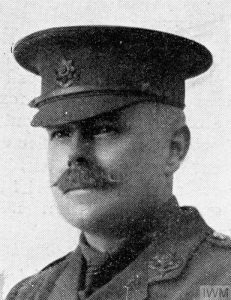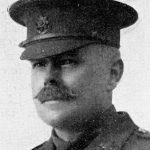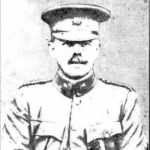
George Herbert Shaw was born in Hull on 12/04/1865. He was the son of John Shaw (1833-1910) and Eliza Joyce (1834-1912), and was educated at Hull College, and in France, Denmark and Germany. John Shaw was a European Corn Merchant. He married Clara Ann Ingleby at Hull in 1890. They had four boys named, Arthur, Edward, Philip and Frank, and a daughter, Dorothy. In 1901 they are recorded at Riverslea on Southfield, Hessle, but later moved to Briar Garth, North Ferriby. In business, Shaw joined the corn merchants Shaw, Son and Company in 1882 and became a partner in 1887. George is listed as a Corn Merchant in the 1901 census.He was known as a genius for organisation and suggested many successful schemes in business and for the 4th Battalion.
In January 1883 he enlisted in the 1st Volunteer Battalion of the East Yorkshire Regiment as a private but by December he had taken a commission as a Lieutenant. In 1892 he was promoted to Captain, in 1898 to the rank of Honorary Major and in October 1904 to Honorary Lieutenant Colonel. he received the Volunteer Decoration (VD) in 1902. By 1914 he was the Battalion Commander of the 4th Battalion. In his youth he was known as an all round athlete and good boxer. He was an excellent shot with both pistol and rifle and represented Yorkshire, winning many titles. Two of his sons served as Officers in the 1/4th East Yorkshire regiment. His other two boys, Philip and Frank served with the 51st Canadian Division
George Shaw was killed in action at St Julien in 1915. On April 22nd the war took on a frightening new aspect for it was then, at about 5 pm, that the Germans launched the first gas attack on the western front as part of the second battle of Ypres. The battalion was located near Ypres where they were engaged in battle at St Julien. On the banks of the Yser canal the 4th Battalion suffered its first casualties, on the 24th April when four men were wounded. In the evening two platoons of D Company, EYR, led by Lt Col G H Shaw attacked the enemy. During the fighting Shaw was shot through the head by a sniper, located in a farmhouse. The sniper was subsequently rushed and bayoneted. His death was described in the Hull Daily Mail on 30/04/1915. *
He was one of seven Lieutenant-Colonels of the East Yorkshire Regiment to be killed in the war. Shaw does not seem to have been decorated for his wartime service, nor even mentioned in dispatches.
Shaw is recorded on the Menin Gate memorial at Ypres in Belgium. Although he is recorded as George Hubert Shaw by the Commonwealth War Graves Commission, he was listed as George Herbert on the original enlistment records of the 4th East Yorkshire Volunteers Battalion in 1883. His name is not recorded on the North Ferriby War memorial, or on Hessle War Memorial. He left £16, 858 in his will to his widow Clara, who lived at St Helliers, Newland Park, Hull (probate address). Clara Shaw dedicated a Memorial Window and financed the “Golden Book” memorial at Hull Minster.
A Plaque was raised to Lt Colonel Shaw at Hull Minster and includes, his son Francis Leslie Shaw, who fought for the Canadians, and was also killed in action, on 26/09/1916, aged 22.
1/4th Battalion – The Northumbrian Division became part of Central Force in Home Defence, tasked with manning the Tyne Defences, so after some days digging trenches in South Holderness 4th East Yorkshires moved to Hummersknott Park, near Darlington to join the York & Durham Brigade. In mid-October it moved again, to Newcastle upon Tyne. It was not until November that the Home Service and unfit men were separated into the 2/4th Battalion, and that battalion’s staff returned to Londesborough Barracks to begin training the recruits
While working on the Tyne Defences, the Northumbrian Division was also undergoing battle training. In April 1915 it was warned for overseas service with the British Expeditionary Force (BEF), and on 16 April its units began to entrain for the embarkation ports. 1/4th East Yorkshires landed at Boulogne the following day.
Second Battle of Ypres – The Northumbrian Division completed its concentration in the Steenvoorde area on 23 April, and went into action the very next day during the Second Battle of Ypres. The York and Durham Brigade went by motor bus to Poperinghe, where they debussed and marched to camp at Vlamertinghe. They were turned out at 01.00 on 24 April and marched to take over trenches astride the Yser Canal, where they came under shellfire at first light, 1/4th East Yorkshires losing their first casualties of the war. During the morning the battalion was shifted again, to a position near Potijze Château, where they dug in again. Meanwhile, the Canadian Division were coming under heavy pressure (the beginning of the Battle of St Julien). Finally, at 15.00 the tired battalion was ordered out to support a counter-attack by the Canadians and the 1/4th Green Howards of the York & Durham Bde (the Canadians were not informed of these two battalions’ involvement). The battalion moved up into a small wood and waited alongside the Canadian artillery under shellfire while the attack developed. Shortly after 17.00 the battalion was ordered to attack towards St Julien and advanced in ‘artillery formation’, with two platoons of D Company in front, led by Lt-Col Shaw. On reaching Bridge House the battalion swung north towards St Julien; it now came under heavy rifle and machine gun fire and was swept by Shrapnel shells and heavy howitzer shells. Eye-witnesses described the tired and hungry battalion behaving ‘as if they were doing an attack practice in peace’. At 950 yards (870 m) and again at 500 yards (460 m) the men opened rifle fire on the enemy, with little apparent effect. Coming upon a road the battalion could advance no further against the hostile fire, and took cover. Lieutenant-Colonel Shaw had been killed by a rifle bullet during the advance, and the CO of the Green Howards took over both battalions. The East Yorkshires were ordered to stay where they were until nightfall; they saw no sign of the Canadians who were supposed to be in St Julien, but their rifle fire combined with the Canadian artillery broke up a German attack from the village, and neither side held it at the end of the day. 1/4th East Yorkshires was permitted to withdraw after dark; in its first action the battalion had lost three officers and 12 other ranks killed, 66 wounded and 17 missing, of whom 10 were known to be wounded. Next morning the 1/4th Bn took over some support trenches in the ‘GHQ Line’, where it was shelled all day, before being withdrawn during the night to march through the ruins of Ypres to a rest camp west of the town. Two days later they went back into the line, supporting 4th Division in a succession of poor trenches under intermittent shellfire. The Battle of St Julien continued for several more days, with the Ypres Salient becoming an increasingly dangerous position. On 2 and 3 May the Northumbrian Division was involved in a general withdrawal to a more defensible line. On 4 May the battalion settled into bivouacs near Steenvoorde, having suffered 33 killed and 58 wounded since 1 May.

